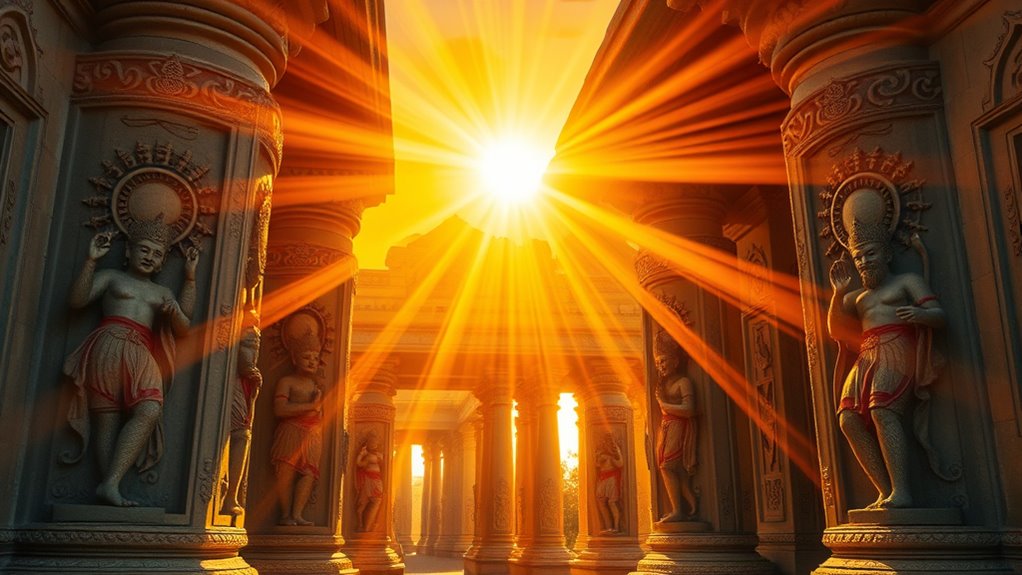In many mythologies, light, especially from suns and celestial beams, symbolizes divine power, cosmic order, and spiritual insight. Solar gods like Ra, Helios, or Surya reveal truths, dispel darkness, and represent life-giving forces. Light is often a metaphor for divine presence and enlightenment, guiding humans toward moral clarity and spiritual rebirth. Exploring these stories shows how cultures view divine illumination as essential to understanding the universe and our place within it. If you continue, you’ll discover more about this fascinating connection.
Key Takeaways
- Many cultures personify the sun as a divine god controlling life, light, and cosmic order, such as Ra, Helios, and Surya.
- Light in mythology symbolizes divine presence, spiritual insight, and moral clarity across various civilizations.
- Solar deities represent cosmic power, renewal, and spiritual rebirth, emphasizing the sun’s transformative role.
- Mythic stories use light as a metaphor for divine knowledge, enlightenment, and revealing hidden truths.
- The centrality of solar myths reflects humanity’s universal pursuit of divine connection and understanding of the universe.

Have you ever wondered how light has shaped mythologies across cultures? It’s a fascinating journey through the stories people have told for centuries, where the sun isn’t just a star but a powerful symbol of life, divine authority, and cosmic insight. Many ancient civilizations worshiped solar deities—gods associated with the sun—believing they controlled the cycle of day and night, growth, and even fate itself. These solar deities often embodied mythic illumination, representing more than just physical light; they stood for clarity, truth, and enlightenment that illuminated the spiritual path for followers. In Egyptian mythology, Ra, the sun god, was considered the creator of all life, traveling across the sky in his solar boat, bringing warmth and vitality to the world. The Greeks revered Helios, who drove his chariot across the sky each day, a radiant figure embodying the power of mythic illumination that reveals hidden truths and dispels darkness.
Across cultures, light in mythology isn’t merely a physical phenomenon but a symbol of divine presence and cosmic order. In Hindu tradition, Surya, the sun god, is revered as a source of life force and spiritual awakening. His rays are seen as divine beams that dispel ignorance and illuminate the soul’s inner light. Native American mythologies often depict the sun as a life-giving force, with stories emphasizing its role in creation and sustenance, reinforcing the idea that celestial light is a divine blessing. These myths elevate the sun’s glow from mere illumination to a sacred force that sustains and transforms life, echoing the universal human desire for understanding and clarity. Additionally, the symbolism of light in mythology underscores its role as a universal metaphor for knowledge, insight, and divine truth.
This mythic illumination often signifies more than physical brightness; it embodies knowledge, insight, and divine truth. In many stories, the sun’s light is a metaphor for enlightenment, guiding mortals toward wisdom and moral clarity. It’s no coincidence that so many cultures personify the sun as a deity—because their stories reflect a shared belief that divine light reveals what is hidden, dispels darkness, and grants humans a glimpse of the divine plan. Whether through the fierce, life-bringing rays of solar deities or gentle dawns that signal renewal, mythic illumination plays a central role in shaping cultural perspectives on the cosmos and humanity’s place within it. It reminds us that light isn’t just about visibility but about understanding, divine connection, and the eternal pursuit of truth.
Frequently Asked Questions
How Do Different Cultures Interpret Divine Light?
Different cultures interpret divine light as sacred radiance, symbolizing purity, enlightenment, and power. You might see divine illumination as a sign of divine presence or blessing, shining brightly to guide or protect. In some traditions, this sacred radiance connects humans with higher spheres or gods, serving as a spiritual beacon. Whether in temples, rituals, or stories, divine light consistently embodies the divine’s essence and influence across diverse cultural beliefs.
What Are the Scientific Explanations for Mythological Sun Myths?
Did you know that solar phenomena like sunspots and solar flares can influence ancient myths? Scientific explanations suggest that celestial illumination from the sun’s intense energy inspired mythological stories, as early cultures observed sunrises, solar eclipses, and other phenomena. These celestial events created awe, leading people to craft myths about gods and cosmic beams, which helped explain the natural world through the lens of divine power.
How Is Cosmic Energy Represented in Ancient Art?
You see cosmic energy in ancient art through light symbolism, often depicted as radiant halos, shining lines, or luminous backgrounds. These elements represent cosmic illumination, illustrating divine power or spiritual awakening. When you observe intricate patterns and bright colors, you’re witnessing an artistic interpretation of cosmic energy, emphasizing the connection between the divine and the universe. Such imagery captures the essence of illumination that transcends physical light, symbolizing spiritual enlightenment and cosmic harmony.
Are There Modern Spiritual Practices Involving Light Symbolism?
Yes, modern spiritual practices often involve light symbolism, like light therapy and spiritual illumination. You might participate in guided meditations where light represents clarity and healing, or use light therapy to activate your inner energy. These practices tap into the idea that light fosters spiritual growth and well-being, echoing ancient beliefs but adapted for contemporary wellness and mindfulness. So, light continues to serve as a powerful symbol of transformation today.
What Are the Psychological Effects of Light in Religious Rituals?
You experience that light in religious rituals can boost your meditative illumination, helping you focus and calm your mind. This visual cue often triggers feelings of spiritual awakening, fostering a sense of connection and inner peace. The warmth and brightness can also reduce stress and anxiety, making you more receptive to spiritual insights. Overall, light’s psychological effects deepen your religious experience and support your journey toward inner clarity.
Conclusion
As you explore these stories, remember that light often gently guides us through life’s mysteries, much like a comforting whisper in the dark. The gods and myths remind us that even in moments of shadow, there’s a subtle glow waiting to lead us forward. Embrace these luminous tales as a gentle reminder that hope and inspiration are always just beyond the horizon, quietly illuminating our path with warmth and wonder.









